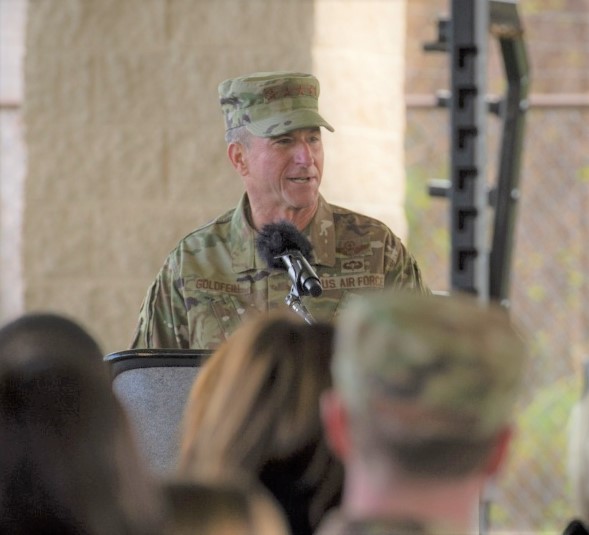
Air Force Chief of Staff Gen. David L. Goldfein gives remarks during the Special Tactics Ruck March Memorial Ceremony at Hurlburt Field, Florida, March 4, 2018. Twenty Special Tactics Airmen rucked from Medina Annex at Lackland Air Force Base, Texas to Hurlburt Field, to pay tribute to Staff Sgt. Dylan J. Elchin who was killed in Afghanistan on Nov. 27, 2018, and in honor of the other 19 Special Tactics Airmen who have been killed in action since 9/11. (U.S. Air Force photo by Senior Airman Joseph Pick)
Twenty Special Tactics Airmen culminated their 830-mile Special Tactics Memorial March for fallen brethren on March 4 with a memorial ceremony hosted by Air Force Special Operations Command.
The ceremony was officiated by Air Force Chief of Staff Gen. David L. Goldfein at the Special Tactics Training Squadron.
“The quiet professionals that we remember today served others, they pushed limits of human condition and endured without a hint of entitlement,” said Air Force Chief of Staff Gen. David L. Goldfein. “For me, that’s the essence of Special Tactics, you do what others cannot or will not do. Part of a broader special operations family–where the example of those remembered today inspires everyone to give a little bit more.”
The march was planned to pay tribute to Staff Sgt. Dylan J. Elchin, a Special Tactics combat controller, who was killed in Afghanistan on Nov. 27, 2018, and in honor of the other 19 Special Tactics Airmen who have been killed in action since 9/11.
Elchin, along with U.S. Army Capt. Andrew Ross and U.S. Army Sgt. 1st Class Eric Emond, were killed in action when their vehicle hit an improvised explosive device in Ghazni Province, Afghanistan, Nov. 27, 2018, while deployed in support of OPERATION Freedom’s Sentinel. U.S. Army Sgt. Jason McClary died later as a result of injuries sustained from the IED.
“This is family business, and you’ll always be part of our Air Force family,” said Goldfein. “Because we’re all part of joint warfighting team. We train together, fight together, bleed together, and mourn together.”
Many Gold Star families from AFSOC and sister services were in attendance for the event.
“We are committed to ensuring that your father, your husband, your son, your brother, will never die twice. First, on the worst day of your life, when they make that ultimate sacrifice and again, if their service were ever to stop saying their name. We will always remember.”
Coverage for the ceremony can be seen via Facebook at: www.facebook.com/AirForceSpecialTactics.
Historically, Air Force Special Tactics plans a memorial march when a member is killed in action. This is the fifth Special Tactics memorial ruck march since it originated in 2009 as the “Tim Davis Memorial March.”
The ruck began Feb. 22 at Medina Annex on Lackland Air Force Base, Texas, where Special Tactics Airmen begin their training together. These future operators then become combat ready upon graduation of the Special Tactics Training Squadron at Hurlburt Field. Ultimately, the march route mimicked the training passage our Airmen endure.
The journey took the Airmen across five states and 830 miles.
A memorial baton inscribed with each of the fallen Special Tactics Airman’s names was carried throughout the way to honor the fallen:
- Master Sgt. William McDaniel of Greenville, Ohio, Special Tactics Pararescueman, Feb. 22, 2002
- Staff Sgt. Juan Ridout of Oak Harbor, Wa., Special Tactics Pararescueman, Feb. 22, 2002
- Master Sgt. John Chapman of Windsor Locks, Conn., Special Tactics Combat Controller, Mar. 4, 2002
- Senior Airman Jason Cunningham of Camarillo, Calif., Special Tactics Pararescueman, Mar. 4, 2002
- Staff Sgt. Scott Sather of Clio, Mich., Special Tactics Combat Controller, April 8, 2003
- Capt. Derek Argel of Lompoc, Calif., Special Tactics Officer, May 30, 2005
- Capt. Jeremy Fresques of Clarksdale, Ariz., Special Tactics Officer, May 30, 2005
- Staff Sgt. Casey Crate of Spanaway, Wash., Special Tactics Combat Controller, May 30, 2005
- Senior Airman Adam Servais of Onalaska, Wis., Special Tactics Combat Controller, Aug. 19, 2006
- Technical Sgt. Scott Duffman of Albuquerque, N.M., Special Tactics Pararescueman, Feb. 18, 2007
- Technical Sgt. William Jefferson of Norfolk, Va., Special Tactics Combat Controller, Mar. 22, 2008
- Staff Sgt. Timothy Davis of Aberdeen, Wash., Special Tactics Combat Controller, Feb. 20, 2009
- Senior Airman Daniel Sanchez of El Paso, Texas, Special Tactics Combat Controller, Sep. 16, 2010
- Senior Airman Mark Forester of Tuscaloosa, Ala., Special Tactics Combat Controller, Sep. 29, 2010
- Technical Sgt. John Brown of Tallahassee, Special Tactics Pararescueman, Aug. 6, 2011
- Technical Sgt. Daniel Zerbe of York, Pa., Special Tactics Pararescueman, Aug. 6, 2011
- Staff Sgt. Andrew Harvell of Long Beach, Calif., Special Tactics Combat Controller, Aug. 6, 2011
- Capt. Matthew Roland of Lexington, Ky., Special Tactics Officer, Aug. 26, 2015
- Staff Sgt. Forrest Sibley of Pensacola, Special Tactics Combat Controller, Aug. 26, 2015
- Staff Sgt. Dylan Elchin of Hookstown, Pa., Special Tactics Combat Controller, Nov. 27, 2018
The ruck marchers were composed of 10 teams of two Special Tactics Airmen. Each team rucked an average of 12 miles per leg and alternated teams. Each day, the teams rucked a combined 70 miles to complete the 830-mile journey over 11 days.
Today, there are about 1,000 Special Tactics operators who combine the core skills of special operations forces with the tactical integration of the world’s greatest airpower, working to find unique solutions to ground problems. They are the most decorated community in the Air Force since the end of the Vietnam War, with one Medal of Honor, ten Air Force Crosses, and 44 Silver Stars.
Special Tactics is U.S. Special Operation Command’s tactical air and ground integration force, and the Air Force’s special operations ground force, leading Global Access, Precision Strike, Personnel Recovery and Battlefield Surgery operations on the battlefield.





































